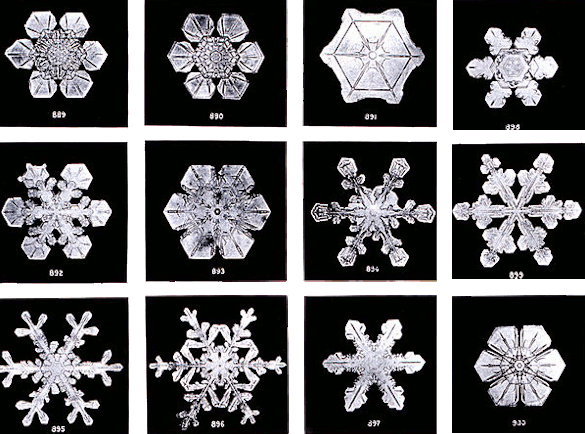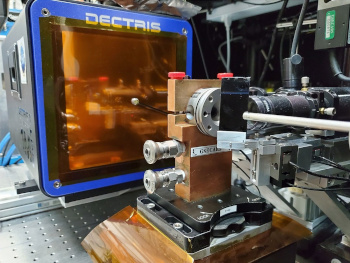Hot Black Ice
December 13, 2021
Cold winter weather is arriving at
Tikalon's Northeast New Jersey home; so, it's time to tune-up the
snow blower.
Illustrators depict cold in various ways, such as
icicles on an old-style
glass thermometer and stylized
snowflakes. Nineteen different
phases of ice are known, each existing in its own
temperature and
pressure range. The common ice that we fight in cold weather is, not surprisingly, known as
Ice-I.
While Ice-I specifies the
hexagonally symmetric crystal cell from which all
snowflakes are constructed, the
random nature of the actual
crystallization ensures that none of the
septillion (10
24)
annually produced snowflakes are identical.[1]
Robert Hooke's 1665 book,
Micrographia, included many drawings of snowflakes. Hooke's drawings were the first to show the complex
shapes within shapes in snowflakes; and, after the
invention of
photography,
Vermont farmer,
Wilson Alwyn Bentley (1865-1931), took numerous
photomicrographs of snowflakes that showed how unlikely that two could be identical (see figure).

Snowflakes photographed in 1902 at Jericho, Vermont, by Wilson Alwyn Bentley (1865-1931)). Bentley took numerous photomicrographs of snowflakes starting in 1885, and these gave anecdotal evidence to the conjecture that no two could be identical. (Reformatted Wikimedia Commons image.)
A snowflake's uniqueness and fragility are the origin of the
slang term, snowflake, to describe a person with an inflated sense of uniqueness who is easily offended. A
mathematical object known as the
Koch snowflake is a
fractal curve
invented in 1904 by the
Swedish mathematician,
Helge von Koch (1870-1924) and shown in the following figure.

A Koch snowflake in its fourth iteration.
The snowflake, as shown, is simply constructed. (1) Draw an equilateral triangle. (2) Taking each line segment in turn, divide it into three equal segments. (3) Draw an equilateral triangle pointing outwards using the middle segment as the base. (4) Remove the base. (5) Continue this operation for the next two line segments of the original triangle; and then recursively for all line segments.
In the limit of an infinite number of such iterations, the Koch snowflake has a fractal dimension, ln(4)/ln(3), or about 1.26.
(Wikimedia Commons image. Click for larger image.)
As I wrote in a
previous article (Snowflakes, January 18, 2011), it's even possible to have ice under
room temperature and
atmospheric pressure conditions when it's confined to a
small dimension.[2] As the
phase diagram of water reveals, application of higher pressure allows some stable forms of ice to exist at higher temperatures. A new extreme at the high pressure and high temperature corner of the water phase diagram was achieved in
research published in
Nature Physics.[3-5]. Team members were from the
University of Chicago (Chicago, Illinois), the
Carnegie Institution of Washington (Washington, DC), and the
GFZ German Research Center for Geosciences (Potsdam, Germany). This ice, a
superionic ice is designated as
ice XVIII.[6]
Superionic ices, ices with with highly mobile
protons contained in a stable
oxygen crystal sublattice have been predicted at high pressures, but it's been difficult for
theory to predict the exact pressure and temperature conditions at which they would occur, and prior
experiments gave contradictory results depending on the techniques used.[3] This ice XVIII superionic phase was created for an instant in
shockwave experiments, but this new study created the phase for a much longer time using the traditional
diamond anvil cell technique and
laser heating.[5]
X-ray analysis was used to determine the crystal structure of the ice.[5]
The experiments revealed that the superionic ice phase was stable at about 20
gigapascals, much lower than the 50 gigapascals predicted by theory.[5-6] Says
Vitali Prakapenka, a study
co-author and
professor at the University of Chicago,
"It was a surprise - everyone thought this phase wouldn't appear until you are at much higher pressures than where we first find it... But we were able to very accurately map the properties of this new ice, which constitutes a new phase of matter, thanks to several powerful tools."[5]

Apparatus used for the creation and analysis of the superionic phase of ice, ice XVIII.
The cube at the left is a photon-counting X-ray detector used for determination of the crystal structure by X-ray diffraction. The device converts X-ray photons to electrical charges in an imaging array.
(Argonne National Laboratory image by Vitali Prakapenka. Click for larger image.)
While all other ice crystals are built from intact water
molecules, the superionic Ice XVIII crystal has oxygen atoms that form a
cubic lattice with freely moving hydrogen atoms existing as a
liquid in the rigid oxygen lattice.[6] The hydrogen atoms are responsible for the
electrical conductivity of the ice, and this has consequences for the
magnetic fields of water-rich
gas giant planets, such as
Neptune and
Uranus.[3,5-6] This ice is a mushy solid, so it would
flow, but not truly
churn, and this would restrict the magnetic field
dynamo action to shallower depths.[6] The
physical properties of Ice XVIII have yet to be explored.[4-5] Says Prakapenka, "It's a new
state of matter, so it basically acts as a new
material, and it may be different from what we thought."[5]
References:
- Is it true that no two snow crystals are alike? Library of Congress Everyday Mysteries Meteorology, Climatology Website/
- K.B. Jinesh and J.W.M. Frenken, "Experimental Evidence for Ice Formation at Room Temperature," Physical Review Letters vol. 101, no. 3 (July 15, 2008), article no. 036101, DOI: https://doi.org/10.1103/PhysRevLett.101.036101.
- Vitali B. Prakapenka, Nicholas Holtgrewe, Sergey S. Lobanov, and Alexander F. Goncharov, "Structure and properties of two superionic ice phases," Nature Physics (October 14, 2021), DOI: https://doi.org/10.1038/s41567-021-01351-8.
- Simone Anzellini, Hot black ices. Nature Physics (October 14, 2021), DOI: https://doi.org/10.1038/s41567-021-01358-1.
- Louise Lerner, "Scientists find strange black ‘superionic ice' that could exist inside other planets," Argonne National Laboratory Press Release, October 28, 2021.
- Joshua Sokol, "Black, Hot Ice May Be Nature's Most Common Form of Water," Quanta Magazine, May 8, 2019.
Linked Keywords: Cold; winter; weather; Tikalon; Morris County, New Jersey; Northeast New Jersey; snow blower; illustration; illustrator; icicle; mercury-in-glass thermometer; snowflake; phases of ice; temperature; pressure; Ice Ih; hexagonal; symmetry; symmetric; crystal; crystal structure - unit cell; randomness; random nature; crystallization; names of large numbers; septillion; year; annual; Robert Hooke; Micrographia; shape (geometry); invention; photography; Vermont; Wilson Alwyn Bentley (1865-1931); micrograph; photomicrograph; Jericho, Vermont; anecdotal evidence; conjecture; Wikimedia Commons; slang term, snowflake; mathematics; mathematical; Koch snowflake; fractal; invented; Swedish; mathematician; Helge von Koch (1870-1924); Koch snowflake in its fourth iteration; geometric construction; constructed; equilateral triangle; line segment; base (geometry); recursion; recursive; limit (mathematics); infinity; infinite number; fractal dimension; room temperature; atmospheric pressure; nanoscopic scale; small dimension; phase diagram of water; research; scientific literature; publish; Nature Physics; University of Chicago (Chicago, Illinois); Carnegie Institution of Washington (Washington, DC); GFZ German Research Center for Geosciences (Potsdam, Germany); superionic water; superionic ice; ice XVIII; proton; oxygen; crystal sublattice; theory; experiment; shockwave; diamond anvil cell; laser; X-ray crystallography; X-ray analysis; pascal (unit); gigapascal; Vitali Prakapenka; co-author; professor; laboratory equipment; apparatus; superionic phase of ice; cube; photon-counting X-ray detector; X-ray diffraction; X-ray; photon; electrical charge; digital imaging; array; molecule; cubic crystal system; cubic lattice; liquid; electrical conductivity; magnetic field; gas giant planet; Neptune; Uranus; fluid dynamics; flow; churn; dynamo theory; physics; physical; state of matter; material.